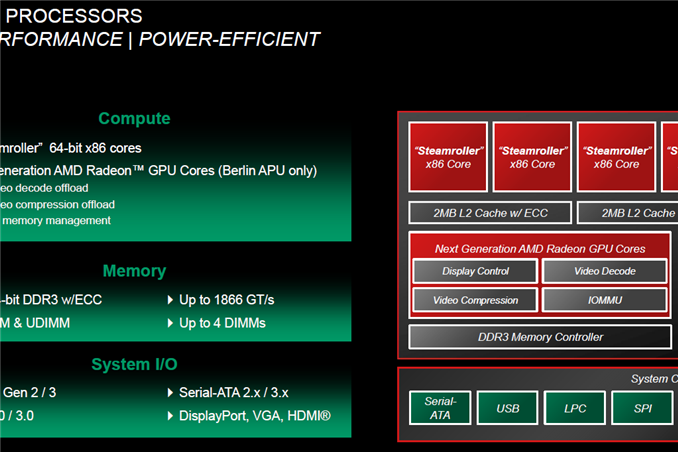AMD Evolving Fast to Survive in the Server Market Jungle
by Johan De Gelas on June 18, 2013 6:00 AM EST- Posted in
- AMD
- CPUs
- Arm
- Enterprise

There are two important trends in the server market: it is growing and it is evolving fast. It is growing fast as the number of client devices is exploding. Only one third of the world population has access to the internet, but the number of internet users is increasing by 8 to 12% each year.
Most of the processing happens now on the server side (“in the cloud”), so the server market is evolving fast as the more efficient an enterprise can deliver IT services to all those smartphones, tablets and pcs, the higher the profit margins and the survival chances.
And that is why there is so much interest in the new star, the “micro server”.
The Demand for Micro-Servers
The demand for very low power server is, although it is high on the hype curve, certainly not imaginary. When you run heterogeneous workloads, for example a mailserver, an OLAP database and several web and fileservers, some of these workloads will be demanding heavy processing power, others will be close to idle. In that case it is best to buy a dual "large core" CPU (or better) server, install a hypervisor and cut the machine up in resource pools. As one workload demands high processing power, your hardware and hypervisor will deliver it. Single thread performance will determine for a large part whether a complex SQL query is responded in a fraction of a second or several seconds. The virtualization layer gives you extra bonuses such as high availability, no more unplanned downtime etc.
If your web based workloads are very homogenous and you know how much horsepower your webapplication needs, things are very different. The virtualization layer is just adding complexity and cost now. In this case it is a lot more efficient to scale out than to divide your heavy server into virtual machines. The single thread performance has to be good enough to respond to a request quickly enough. But throughput demands can be handled by adding a load balancer in front of low power servers. It is much easier to scale this way.
The problem is that the your average server is not well suited for these kind of homogenous workloads. Yes, servers have become a lot more efficient by including advanced power management features. The introduction of CPU C-states and more efficient PSUs are among the top of technologies that saved a lot of power. However, even the most modern servers are still needlessly complex with lots of disk, network and other interfaces. A useless interface wastes a few hundred of mwatt and a less efficient PHY (Copper 10 Gbit Ethernet for example) wastes a few Watt, but in the end it adds up.











80 Comments
View All Comments
coburn_c - Tuesday, June 18, 2013 - link
AMD is no less than doomed if this is all they've got. I say this with sadness and regret.... and anger. There are definitely a few former CEOs who deserve to be publicly beaten.They doomed themselves when they chose to leverage half the company for ATI just before the second great depression and they doubled down on defeat when they sold off their greatest asset: their fabs. Then, just to seal the deal, they decided that the longer pipelines and greater complexity that had almost ruined Intel the decade before would save them. Without in-house fabs to achieve the efficiency. Without the talent to realize the vision. Without floating point units...
JohanAnandtech - Tuesday, June 18, 2013 - link
I have to disagree. With Ivy Bridge EP Xeons out soon, the Warsaw product is probably too little, too late. However, the Seattle and Berlin CPUs can carve out their niches. Don't underestimate the micro server market. It is similar to x86 server market back in the late 90ies. It started small and in a niche, but it quickly grew upwards.gostan - Tuesday, June 18, 2013 - link
Not underestimating the micro server market here. just that I don't have high hope on AMD to execute their roadmap in a timely fashion.TheCountess - Tuesday, June 18, 2013 - link
actually they hit all their launch targets in recent years, even if not always the performance they were hoping for.raghu78 - Tuesday, June 18, 2013 - link
its frustrating to not see Steamroller based 2P and 4P Opterons. AMD has failed badly in execution. The original Bulldozer was released in late Q3 and Q4 2011 . the Piledriver updates happened in Q4 2012. Steamroller based updates should have been released by Q4 2013 or Q1 2014. but now thats not going to be the case. AMD's execution of big core based products has been miserable.In Feb 2012 during the Financial Analyst Day , AMD talked of Kaveri being their 2013 APU. By late 2012 it was clear that Steamroller based Kaveri was delayed. So AMD cooked up a mild Trinity update called Richland and marketed it as the new 2013 APU. Whats worse is AMD is hit badly by Globalfoundries screwing up their 28nm bulk process.
The only hope is that AMD go direct to Excavator for the real next big core based Opteron 2P / 4P products with a DDR4 based new platform in late 2014 or Q1 2015. The question is what process will AMD be using. AMD needs a 20nm process based Excavator product to have any chance against Haswell EP / EX.
Intel has no competition till late 2014 in the traditional IT server market. AMD 's problem is they are at the mercy of foundries for process tech , which are atleast 1 generation behind Intel and even more if you count features like FINFET. Intel's transistor performance is unmatched. So given AMD are behind on process tech by a generation , they need to out-architect Intel which is a very difficult task. But against all these odds everyone is hoping AMD can compete against Intel in the big core race. lets see what AMD has in store with Excavator based Opteron refreshes.
dgingeri - Tuesday, June 18, 2013 - link
AMD isn't in as bad a position as you seem to think. They aren't good competition for Intel in the high end, true, but performance per dollar in the midrange and low range server market is definitely AMD's area of dominance. I have several AMD based Dell R515 machines in my lab. They perform very well, especially as virtual hosts, for a good price range. They're a good $500-700 cheaper than the equal performing Intel based machines, or in other terms, you can get two more cores per socket and two 1TB hard drives for the same price. Don't count them out just yet.Strunf - Tuesday, June 18, 2013 - link
The problem is that low and middle end don't provide that much of profit, as in AMD as to sell loads of them just to recover the costs of R&D, they don't even have their own fabs anymore so besides paying the R&D they also have to pay someone else to actually make them, plus they will soon have real competition from the ARM cause let's be honest ARM will start eating AMD market share at a much faster rate than eating Intel market share, this cause exactly of what you said, Intel owns the performance sector and the ones that want performance will not consider ARM solutions (for the time being).Hector Ruiz was probably one of the worst CEO from the AMD history and just to think he had a bigger pay check that the CEO of Intel makes me wonder how AMD as a company is being run...
JPForums - Tuesday, June 18, 2013 - link
Unfortunately, $500-$700 is often a drop in the bucket compared to the software costs so a lot of businesses will go Intel despite the superior price/performance ratio. Perhaps more worrisome is the fact that AMD chips are simply larger and more costly than their Intel equivalents. If Intel ever decided to lower their profit margins enough, AMD couldn't compete.I think AMD's current strategy of capitalizing on GPU tech and integration with SeaMicro tech is the appropriate strategy at the moment. They have no real hope of catching up to Intel's process tech and Intel appears to have a superior big chip architecture even without it. Intel is focused on its small chip architecture and given the general CPU expertise, it is probable that they will catch up their as well. However, Intel has historically been less than proficient in regards to graphics. While the new Iris line is pretty impressive, it is hard to say how much of that is efficient architecture and how much is simple brute force. Also, while the Xeon Phi is making great strides in the highend HPC arena, they simply don't yet have the expertise to leverage their on die graphics for compute as simply and easily as AMD's upcoming Berlin (for mainstream or lowend HPC). The longer AMD can maintain their technical advantage here, the better. Hopefully the can also keep building off of the SeaMicro tech to distinguish themselves from the manufacturers that think they can just throw and ARM chip in their server and call it a day.
Klimax - Wednesday, June 19, 2013 - link
I wouldn't be so sure about computing advantage for AMD:http://techreport.com/review/24954/amd-a10-6800k-a...
JPForums - Tuesday, June 18, 2013 - link
AMD was never even with Intel's fabrication technology in the first place. They've always been behind (usually one generation, but sometimes more). The only significant (unique) fab technology I can recall AMD releasing was their Silicon on Insulator (SOI) process, but it was still on a larger node. Also, it wasn't so much that Intel couldn't have used SOI as they just deemed strained silicon more useful for their purposes at the time.Intel has always relied on their process advantage as it allows them to implement architectures that are simply impractical on previous process nodes. Need more performance in the same power envelope, use a higher performance architecture with a new process node. Need a lower power envelope with the same performance, a smaller process node can help you maintain the same clock speeds on the same architecture while dropping power. Need new features, such as better power management, to reach your target. A smaller process node gives you more transistors to work with to implement those features within the same die size. As cost is rather directly related to die size, they can even effectively change nothing and reduce cost. For a long time clever designs and lower profit margins had helped AMD compete, but Intel simply has far more leeway to screw up without having an appreciable effect on their final product. One less than optimal move by AMD lands them in budget land with no profit margins.
ARM based manufacturers seem to have a more optimal architecture (if only slightly) for low power processors than Intel right now. However, Intel's processes advantage has once again allowed them to achieve a rough parity with their newest Atom architecture. If Intel can close the gap in regards to architectural cleverness, then ARM houses will need to close the gap in fab tech. Otherwise, like AMD, they will be stuck in a situation where one wrong move could relegate them to the budget end (of a budget market). Luckily, there are many ARM houses and they aren't all likely to screw up at the same time.